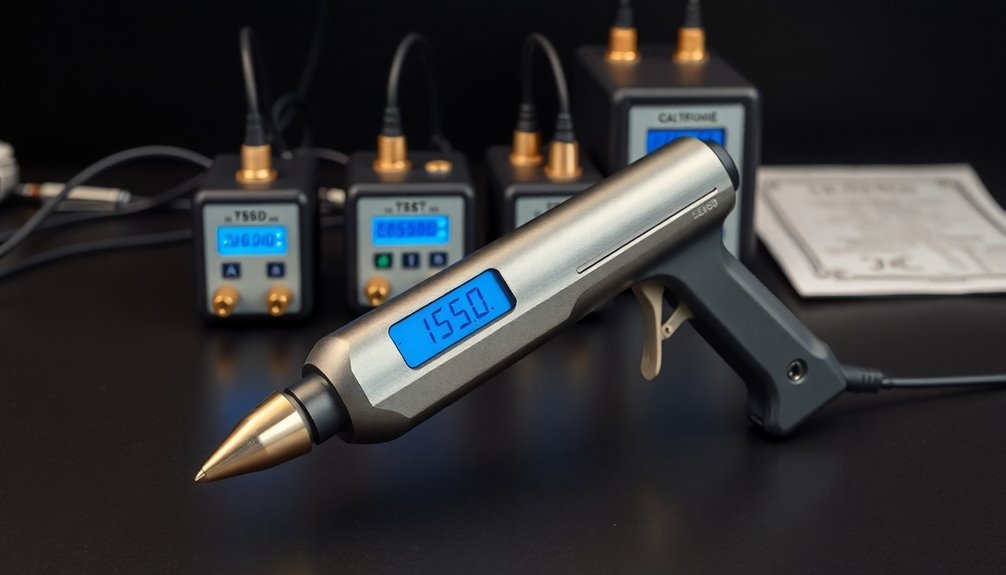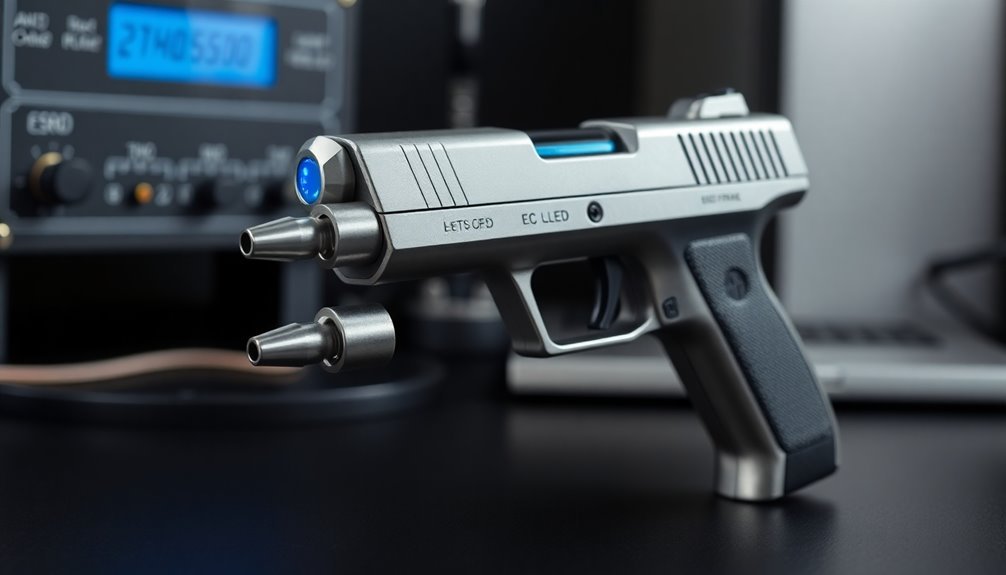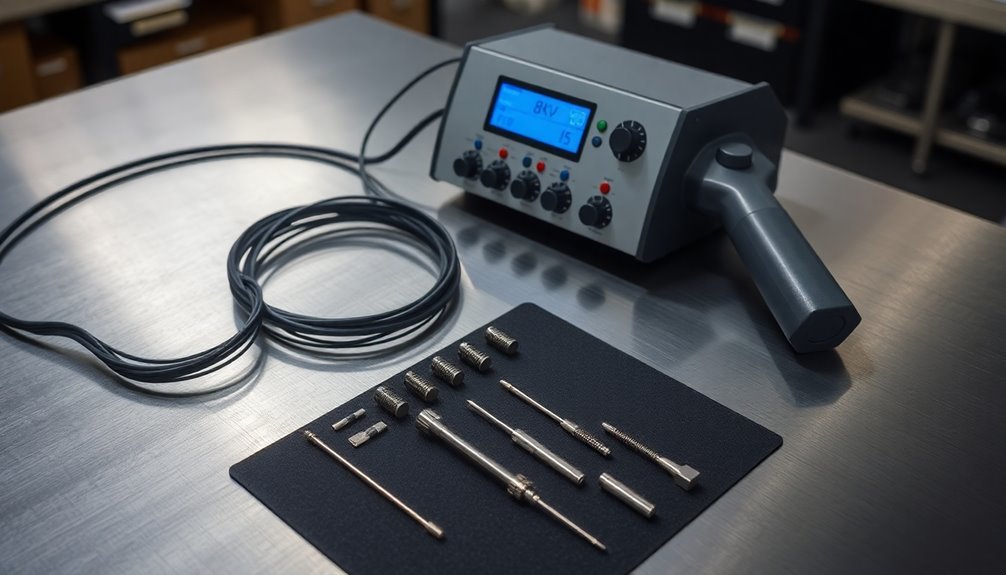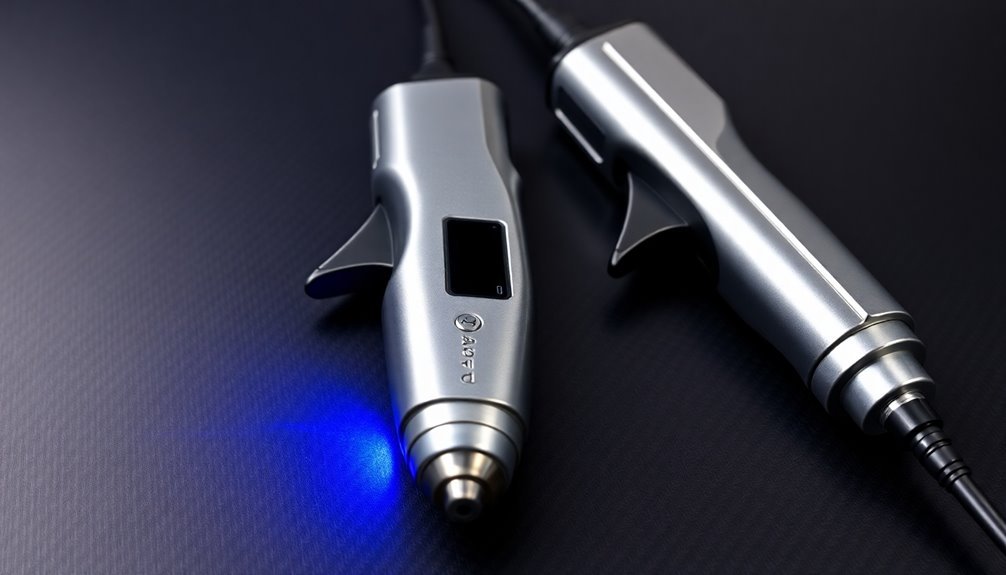You'll find several reliable ESD test gun simulators that meet international standards like IEC 61000-4-2 and ISO 10605. Premium models like the Teseq NSG 438 and Model 930D ESD Gun offer advanced features, including adjustable voltage levels, waveform control, and thorough data storage. For budget-conscious testing, Lisun ESD guns provide essential features while maintaining compliance. When selecting your simulator, look for both air and contact discharge modes, remote capability, and proper calibration options. Consider factors like portability, battery life, and environmental specifications to match your testing needs. The right choice depends on understanding key specifications and industry requirements in detail.
Understanding ESD Test Gun Basics

To guarantee safety and accuracy, you'll need to follow specific procedures.
Always wear proper protective equipment, including rubber gloves and eye protection.
You must also maintain proper grounding connections and work within an ESD-protected area.
Before operating the test gun, you'll need to verify that it complies with relevant standards like IEC 61000-4-2 and ISO 10605.
Regular maintenance of your ESD test gun, including inspection of electrodes, wires, and connectors, will help guarantee reliable testing results.
It is important to select the appropriate discharge electrodes and modules to simulate different types of ESD events accurately.
Top ESD Simulator Models
When choosing an ESD simulator model, you'll find high-end options like the Teseq NSG 438 and Model 930D ESD Gun offering premium features such as advanced waveform control and multi-standard compliance.
These top-tier models provide exceptional accuracy and thorough testing capabilities, with voltage ranges up to 30kV and specialized discharge networks for professional testing environments. Premium models feature remote discharge capability for enhanced operator safety and convenience during testing procedures.
If you're working with budget constraints, manufacturers like Lisun offer cost-effective combination ESD guns that still maintain essential testing capabilities while meeting core standards like IEC 61000-4-2.
Premium High-Performance Models
Looking for the most advanced ESD testing equipment on the market? The Model 930D-FTS Benchtop and 930D ESD Gun Simulator stand out with their impressive ±26,000V capability, upgradeable to ±30,000V. You'll find these models excel in both contact and air discharge testing while meeting critical standards like ANSI/ESDA/JEDEC JS-001-2023 and IEC 61000-4-2.
For international operations, consider the LISUN ESD61000-2, featuring a bilingual LCD touch screen and exhaustive testing capabilities up to 30,000V. The 3ctest EDS 20H offers portability with its battery operation and precise 1000V to 20kV range. These devices are particularly suited for testing pyrotechnic automotive systems including airbag and pretensioner components.
| Feature | 930D Series | LISUN | 3ctest EDS 20H |
|---|---|---|---|
| Max Voltage | 30kV | 30kV | 20kV |
| Display | Digital | Touch LCD | Digital |
| Power Source | Mains | Mains | Battery/Mains |
These premium models offer advanced features like data storage, remote discharge capabilities, and custom discharge networks. You'll benefit from their high-quality waveforms and thorough compliance with international testing standards. For professional testing environments requiring precision and reliability, these models represent the pinnacle of ESD testing technology.
Budget-Friendly Testing Solutions
While premium models offer extensive capabilities, many organizations can achieve reliable ESD testing without breaking the bank. Budget-friendly ESD simulators now provide essential features like flexible RC networks, compliant with IEC 61000-4-2 standards, and both air and contact discharge capabilities.
You'll find these cost-effective options include touch screen interfaces and ergonomic designs that guarantee comfortable long-term testing. Many models offer discharge voltage ranges from 1 kV to 30 kV, meeting most testing requirements while maintaining fast rise times between 0.6-1ns for accurate ESD simulation. Popular models like the Teseq NSG 438 are available for monthly rentals.
To maximize your budget, consider refurbished ESD guns with warranties or rental options for short-term projects. These alternatives often come with calibration services and price-matching guarantees, helping you manage ongoing costs.
Most budget models still maintain compliance with key standards like IEC 61000-4-2 and ISO 10605, featuring automatic polarity switching and repeatable test results.
When selecting a budget-friendly simulator, you won't have to compromise on essential features. Many units include different discharge tips, multiple RC networks, and basic remote control capabilities, guaranteeing you can conduct thorough ESD testing while staying within your financial constraints.
Key Features To Consider

Three core aspects define a quality ESD test gun simulator: its testing capabilities, operational features, and safety standards.
When evaluating testing capabilities, you'll want to look for voltage ranges between 1000V to 16,000V for both air and contact discharge modes. The simulator should offer multiple frequency options from 0.1 to 20 Hz and include both positive and negative polarity settings. Pre-programmed IEC levels are essential for standard compliance testing.
For operational features, prioritize devices with user-friendly interfaces, like a 5.7" touch screen, and precise voltage control with 100V steps. You'll benefit from a portable unit weighing around 7 kg and offering at least 16 hours of battery life. Having virtual field probes integrated into the system allows for precise measurement and visualization of currents and voltages throughout testing.
Check that the simulator supports both air and contact discharge modes with troubleshooting capabilities.
Safety features shouldn't be overlooked. Your simulator should comply with IEC/EN 61010-1 and maintain CAT IV 600V ratings. Consider the environmental specifications – it should operate in temperatures from -20°C to +55°C and handle humidity levels between 20% and 80% RH.
An IP54 rating guarantees protection against dust and water, while altitude ratings up to 2000 meters guarantee reliable operation in various locations.
Standards and Testing Requirements
A thorough understanding of ESD testing standards is essential for reliable product certification. You'll need to comply with IEC 61000-4-2, the primary standard that outlines test methods and requirements for electronic devices.
If you're testing in Europe, you'll also need to follow EN 61000-4-2, while automotive testing requires adherence to ISO 10605. Clean and controlled environments must be maintained during testing to ensure consistent results.
Your testing must include both contact and air discharge methods. Contact discharge is preferred when possible, requiring direct application to the device under test. For areas where contact isn't feasible, you'll use air discharge testing at higher voltages.
The ESD waveform must meet specific requirements, including a 0.8 ns rise time as specified by IEC 61000-4-2.
You'll need to conduct testing at various voltage levels, typically ranging from 2 kV to 8 kV for contact discharge and up to 30 kV for air discharge. Before beginning any tests, you must verify your ESD simulator's performance.
Different industries have specific requirements – medical devices follow EN 60601-1-2, automotive products use ISO 10605, and military equipment must meet MIL-STD-461 CS118 specifications.
Calibration and Maintenance Tips

Once you've established your testing requirements, maintaining the accuracy of your ESD gun becomes your next priority. You'll need to schedule regular calibration services at intervals specified by your manufacturer to comply with standards like IEC 61000-4-2 and ANSI/ESD S20.20. Each calibration should provide you with certification documents that include your device's serial number, test results, and any modifications made. Regular calibration helps maintain output characteristics dependability for consistent testing results.
| Maintenance Task | Frequency | Key Points |
|---|---|---|
| Calibration | As per manufacturer | Get certification documentation |
| Cleaning | Weekly | Use antistatic brushes, lint-free cloths |
| Component Check | Monthly | Inspect for wear, damage, loose parts |
Don't overlook daily maintenance practices. You'll want to keep your ESD gun clean using antistatic brushes and lint-free cloths to remove dust and contaminants. Pay special attention to the discharge electrodes, checking them regularly for signs of wear, distortion, or pitting. Make sure you're documenting all maintenance activities and calibration dates for traceability. If you're working in harsh environments or using your equipment frequently, you might need to adjust these intervals. Remember to keep your firmware updated according to manufacturer recommendations to maintain peak performance.
Common Testing Applications
Test gun simulators play a vital role in manufacturing and automotive testing, where you'll need to verify products against established standards like IEC 61000-4-2 and ISO 10605.
You can test a wide range of consumer electronics, from smartphones to home appliances, ensuring they'll withstand real-world static discharge conditions. Equipment like discharge networks must be properly calibrated to deliver consistent and reliable test results.
In automotive applications, you'll need to validate electronic control units (ECUs), infotainment systems, and safety components to meet strict industry requirements and enhance vehicle reliability.
Manufacturing Product Testing
Throughout modern manufacturing facilities, product testing serves as a critical quality control checkpoint that guarantees consistent performance and reliability.
You'll need to implement thorough testing methods, including stimulus sweeps and environmental testing, to validate your products effectively. By utilizing automated testing platforms and big data analytics, you can streamline your manufacturing process while maintaining rigorous quality standards.
When conducting ESD testing in your manufacturing environment, you'll want to employ both air and contact discharge methods to guarantee complete coverage. Your testing procedures should account for environmental factors like temperature and humidity, as these can markedly impact ESD event frequency.
Modern manufacturing test platforms, integrated with Industry 4.0 principles, enable you to perform efficient, end-to-end testing while collecting valuable data for continuous improvement.
- Feel confident knowing your products can withstand real-world conditions through thorough environmental testing
- Rest assured that your testing meets industry standards with certified ESD simulators
- Trust in the reliability of your products through thorough endurance testing
- Stay ahead of potential issues with predictive analytics and real-time monitoring
- Protect your reputation by guaranteeing consistent product quality through automated testing
Automotive Industry Applications
Modern vehicles demand rigorous ESD testing protocols to guarantee reliability in harsh automotive environments. You'll need to follow ISO 10605 standards when testing automotive components, which requires discharge testing up to 30 kV – substantially higher than commercial standards.
When you're conducting automotive ESD testing, you'll want to use specialized equipment like the LISUN ESD61000-2 or Model 930D ESD guns that can handle these elevated voltage requirements.
You'll need to perform both contact and air discharge methods, though contact discharge typically provides more consistent results in automotive applications.
During testing, you'll need to account for various environmental factors that can affect your results, as vehicles operate across widely different temperature and humidity conditions.
You should use multiple RC networks to simulate different ESD scenarios that vehicles might encounter, including the Human Body Model and IEC networks.
Remember to test both positive and negative polarities, as automotive components must withstand both types of discharge events.
The data you collect will help you optimize your component designs and verify they meet strict automotive safety and reliability standards.
Choosing the Right Simulator

Selecting an appropriate ESD gun simulator requires careful consideration of several critical factors. You'll need to verify that the simulator meets specific test standards like IEC 61000-4-2 and can handle the highest severity levels required by your product specifications.
When choosing your simulator, look for one that offers detailed waveform control, ergonomic design, and clear display indicators for discharge status, battery life, and polarity settings.
Consider simulators that provide versatile testing capabilities, including component-level tests and various ESD models. You'll want features like repetitive modes for troubleshooting and multiple discharge tips for different testing scenarios.
Don't forget to verify the simulator's calibration requirements and verify it includes necessary accessories like tripods and carrying cases.
Imagine the frustration of discovering your simulator can't meet required test levels mid-project.
Think about the confidence you'll feel knowing your tests meet international standards.
Consider the peace of mind that comes with reliable, accurate test results.
Picture the efficiency of having multiple testing capabilities in one device.
Envision the satisfaction of identifying and resolving ESD issues before they reach customers.
Performance and Safety Considerations
Successful ESD testing hinges on both performance accuracy and safety protocols. You'll need to verify that your simulator complies with standards like IEC 61000-4-2 and ISO 10605 while maintaining proper calibration and regular maintenance schedules.
Before testing, verify your simulator's performance using calibrated ESD targets and high-bandwidth oscilloscopes to prevent over or under testing of your equipment.
Safety must be your top priority during testing. Always wear appropriate PPE, including rubber gloves and eye protection, and conduct tests in designated ESD protected areas.
You'll need to properly ground your ESD gun and maintain strict adherence to manufacturer-specified voltage and current limits. Don't forget to use ionizers or antistatic materials to neutralize static charges on test surfaces.
Environmental conditions substantially impact your test results, particularly humidity levels during air discharge testing. You should maintain a static-safe workstation with proper grounding and ESD-safe attire, including wrist straps and dissipative clothing.
Document all test conditions and results thoroughly, including humidity levels and simulator settings. Regular training and equipment inspection will help verify consistent, reliable testing outcomes while maintaining a safe testing environment.
Frequently Asked Questions
Can ESD Simulators Be Used for Testing Medical Devices in Operating Rooms?
You shouldn't use ESD simulators in operating rooms. They're meant for laboratory testing environments only. Instead, conduct all your medical device ESD testing in controlled test facilities before clinical deployment.
How Often Should ESD Simulator Batteries Be Replaced for Optimal Performance?
You should replace your ESD simulator batteries every 2-3 years, or when charge life drops below 8 hours. Don't wait for complete failure – monitor battery performance and replace when you notice significant operational decline.
What Happens if an ESD Simulator Is Accidentally Discharged on Operators?
If you're accidentally hit by an ESD simulator discharge, you'll experience immediate pain, potential burns, and electrical shock. You could face serious health risks, so it's essential to seek medical attention right away.
Are There Special Requirements for Testing Devices With Wireless Capabilities?
Yes, you'll need to conduct EMC testing at an ISO 17025 accredited lab and get TCB certification. Your wireless device must meet specific RF exposure limits and comply with FCC regulations for all frequency bands.
Can Multiple Operators Share Calibration Data Between Different ESD Simulator Models?
You can share calibration data between ESD simulator models, but you'll need to verify compatibility, data formats, and standards compliance. It is crucial to maintain consistent calibration procedures across different devices.
In Summary
You'll find that selecting the right ESD test gun simulator requires carefully weighing your specific testing needs against industry standards and budget constraints. Consider calibration requirements, ease of maintenance, and safety features when making your choice. By focusing on key specifications like voltage range, discharge network options, and testing modes, you'll guarantee reliable static discharge testing that meets your compliance requirements.





Leave a Reply